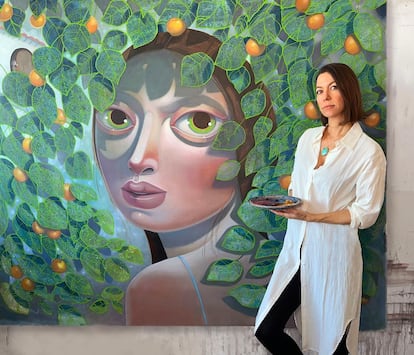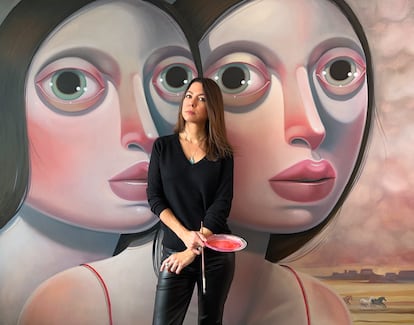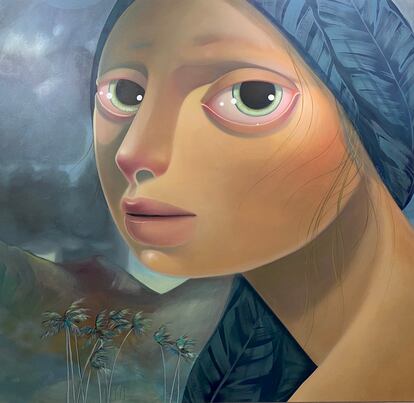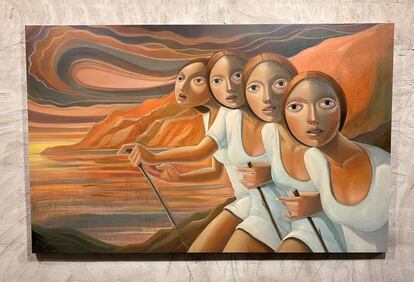Tania Marmolejo: A Latina artist auction sensation
A conversation with the Swedish-Dominican American artist about the immigrant experience, the challenges of being a female artist, and the dangers and rewards of performing exceptionally in a secondary market

“Fulfilling,” she answers when asked to summarize the last 25 years of her life in one word. “Fulfilling,” she emphasizes, slightly narrowing her eyes as if reminiscing. “Because I’ve worked so hard, and my journey has been exciting, very fun, sometimes really hard. I’ve had heartbreak. I’ve had fun. I’ve had success. I’ve found myself at rock bottom and then gone up again,” she adds. “So, after those 25 years to be where I am now, exactly where I am now, I can look back and feel like I’ve reached something that I always wanted to do. I’ve done what I wanted. I’ve reached a place where I want to be. And right now, I’m there. I’m where I want to be, it’s very fulfilling.”
A journey that began for the Swedish-Dominican American artist Tania Marmolejo Andersson with her trip to New York in 1998, after graduating in Fine Arts from the Altos de Chavón School of Design in the Dominican Republic, with a scholarship to continue her studies at Parson The New School for Design, receiving her degree in Fine Arts and Illustration in 2000. “As a student, I had a lot of fun, but it was also very confusing. I arrived at Parsons with a merit scholarship, so my studies were taken care of, but New York was still shockingly expensive,” she explains.
“It was a struggle to find your place there,” she continues. “There are so many people. There were so many types of possibilities of what you could do. I think that at the same time, I was having fun because I was free, I was a young adult, and I was also anxious. It was like, what am I supposed to be doing here? How am I going to live here?” Marmolejo admits. “It’s not a very easy city, and you’re in constant survival mode trying to figure out what steps to take next,” she tells me via videocall from her summer home in Málaga, Spain, where she is spending a few days. She and her husband will go hiking in the Swiss Alps, their main hobby, along with traveling, before the opening of her next exhibition, The Nurturing Wild, on September 2, at Kutlesa Gallery in the center of Switzerland, next to Mount Rigi.

“I think most immigrants sort of feel that even when you are comfortable, you still are constantly trying to figure out where is my place here,” she remarks about her experience as a Latina immigrant in “Gotham City.” “And I was fortunate that I got these design jobs immediately after I graduated. But it was still confusing because those small studios—what we now call startups—struggled hard back then. Television and media were being replaced by the internet very much. I mean, everyone was trying to figure everything out. You didn’t know if your job would be there by summertime,” she remembers her initial struggle to achieve job and professional stability in a competitive and ever-changing industry and city. “It was very stressful, and coming from the Dominican Republic, I wasn’t used to that. But it was a learning experience. As they say, you know, if you can make it here, you can make it anywhere,” she says, laughing with her signature “quick, wraparound smile that could disarm Iran,” as Stephen Kaplan, the Rector of the Altos de Chavón School of Art and Design in the Dominican Republic, likes to remember her. “And I must say that after all the work, living there, and trying and working so hard, you can throw me anywhere in the world, and I feel like I will not only survive, but I will thrive because I think the experience of New York makes you a survivor and a thriver.”
Of these 25 years, the last eight have been particularly decisive for Marmolejo. She quit her day job and put all her cards on the table. Then, immediately after, came the pandemic… But that wasn’t particularly bad for her. It became a watershed. It is as if during the pandemic, while we were all attentive to the count of infections and deaths confined at home, the world had been reorganized. Also, the art world. During this time, several international galleries approached her with exciting proposals, allowing her to open up to other markets outside the Dominican Republic, where she has exhibited with Lyle O’Reitzel for over a decade.
Her efforts and talent have paid off surprisingly on the other side of the world, where she has worked consistently with the South Korean gallery Eligere since 2021. She had her first solo exhibition with the gallery, Anacaona’s Revenge, on September 15, 2021, and her second one in the Asian country, Alter Egos, last March. Eligere has also showcased her work at the prestigious KIAF Plus in 2022 and KIAF Seoul on September 6, 2023.
With the interest in her work on the rise, this has impacted the secondary markets. “In October 2022, her work “I Always Come Back Here” (2020) sold at Sotheby’s Hong Kong for HK$693,000 (US$88,576), a then-record price for the artist at auction. Less than six months later, that price has been beaten twice. “Let the Hurricane In” (2019) sold for HK$1.08 million (US$137,896)—more than seven times its presale low price estimate—at Poly Auctions later that month. In March, Phillips New York also sold “Dreams of Escape” (2021) for US$88,900,” reported Veena McCoole in a market article featured on Artsy.net.

“You’re happy that your art is noticed. And there are people interested. But at the same time, you are afraid of those who call themselves collectors but are trying to make money by buying and selling. They’re going to jump at the chance, and suddenly, they’re going to sell all your work, and there’s going to be too much of your work sold simultaneously. That’s a big fear because then there’s too much of your work on the market. And so, it’s like a dance, this thing with the auctions”, Marmolejo says. “You may be excited when you hear that it’s sold for a good price, and then at the same time, suddenly you’re scared as an artist because what does this mean? Does it mean that everyone will wants to sell your work and try to make money?” she comments on her success at auctions.
The artist is not afraid of respectful legit collectors “who hang onto the artwork for a few years,” but the impact of another kind of buyer replacing volatile stock trading operations with art speculations. “This desire to make a quick buck off an artist has changed how galleries sell work. Now there are three-year, five-year contracts,” she explains the conditions to buy her work to avoid speculation in secondary markets. “Some of them are trying to use art as a new form of currency. Unfortunately, this does not benefit the artist. So, the galleries are trying to balance things to protect the artist. Also, we start creating less work. It becomes harder to balance when there are a lot of so-called collectors who want to sell your work and make a quick buck. And unfortunately, that creates a fluctuation in the prices of the artist. And it scares us a lot.”
Marmolejo’s work attracts attention not only in Asia and the U.S. but also in Spain and Scandinavia. In May 2023, she had her first solo show in Spain at Villazan Gallery in Madrid, with a body of work inspired by the artist’s connection to Spain. Gallery owner Pablo Villazan revealed that the show sold out in the first two days. They were aware of the significant worldwide interest in Marmolejo’s artwork. However, “we can confirm that demand not only has considerably increased but that there is an extensive waiting list,” Villazan disclosed to McCoole.
Since June 2022, Marmolejo has worked tirelessly on her large, elaborated canvases, starring women with intense gazes, showing her work in several collective shows, and conceiving and realizing eight personal exhibitions all around the world, from New York’s GR Gallery to Nicodim LA, from Parisian Cohle to Volery Gallery in Dubai. The next exhibition in the pipeline is a solo show in May in Milan with Carl Kostyál, among other projects that are not cemented yet.
Last June, Marmolejo had a highly anticipated solo show in Stockholm at Loyal Gallery, perhaps her most personal exhibition yet. “What Was Saved From the Fire” exhibited 12 oil paintings dialoguing with her Swedish roots and integrating her maternal grandmother Elsa’s sketches and drawings in some of her works. The exhibition is also a breakthrough in her search for identity as an artist with Scandinavian and Caribbean roots, to which Marmolejo attributes her resilience. “It makes you, in a sense, a chameleon. You can flow between cultures, and you’ll always be a bit of a novelty, which I don’t consider bad. I never have fit into one box, and I never want to. That helps define who I am. And I have found that being mixed is also an identity in itself and that it’s a fun identity. You can do what you want,” she adds, laughing.

“People often like to shelter themselves within an identity and say, I belong here. And you hide within that group. Artists usually, although some like to work collectively, most of the time, artists are trying to find what sets them apart. What sets my art apart from others. So, it’s an interesting juxtaposition that even though you may have or feel you identify with a culture, you still are trying to figure out who you are in that culture,” she points out.
Although she always hoped and prepared for this (not so-sudden) success, it also surprised her. “I hoped with, you know, with my fingers crossed. I don’t know if I expected as much as it has happened, but I knew that if I showed my work more internationally, it would catch on because I had never seen anything like it in the fairs I was a part of. So, I knew more people would be interested if I showed my work. I didn’t realize that this amount of people would be interested. So, there is an element of surprise. But at the same time, I think it was like a hopeful expectation. You know, like you always have a little question mark. Expectation, dot, dot, dot, and a question mark. You always have to knock on wood to say, okay, I don’t want to, you know, jinx it. But yes, if enough people saw it, I felt something larger would happen. But this this is a surprise.”
Does she think we are living in a change of time where women play a more prominent role, have more opportunities, and receive at least a kind of symbolic restitution? Does this have something to do with her success after so many years of struggling and might be a trigger in the interest that his work has aroused? “In many ways, hopefully, we’re entering almost like a new era,” she replies. “There’s much more attention given to women, their leadership qualities, and their ability to create outstanding and exciting projects that nobody doubts. But then we’re struggling so much in other aspects, even in the most liberal countries in the world; we’re getting our decisions and bodies regulated as if we cannot make up our minds on our own. And there are just more and more restrictions, which might be a pushback to the growing dominance of women. And then, at the same time, it should be a more fluid acceptance of both sexes, having women and men working together without discordance. It shouldn’t be so jarring. It shouldn’t be such an issue and then a symbolic restitution. I don’t think we’re there yet anyway. I mean, specifically in art, we’re getting a lot more, but we’re still being questioned, I would say, less than before. And it feels good because I’ve seen how it was not long ago. It’s something that I can see with my own eyes, the change. I hope it continues. I hope it becomes normal. Art should be more inclusive for all genders, races, and cultures,” she says. “Grumpy white, old men shouldn’t control it,” she adds, followed by a mischievous laugh. “Art should be the voice of humanity. And the more varied society becomes and the more we interact with each other, art should reflect that.”

Sign up for our weekly newsletter to get more English-language news coverage from EL PAÍS USA Edition